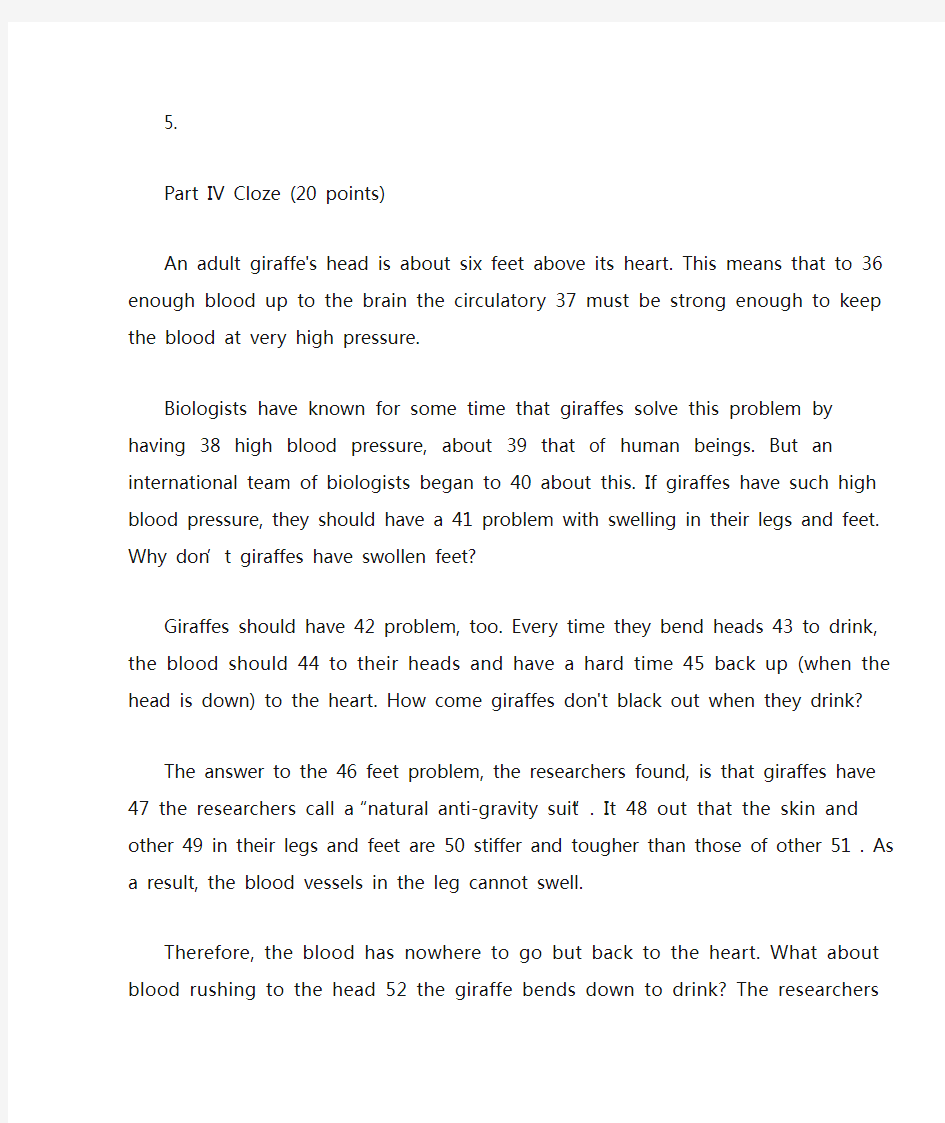东财学位英语完型题库

- 1、下载文档前请自行甄别文档内容的完整性,平台不提供额外的编辑、内容补充、找答案等附加服务。
- 2、"仅部分预览"的文档,不可在线预览部分如存在完整性等问题,可反馈申请退款(可完整预览的文档不适用该条件!)。
- 3、如文档侵犯您的权益,请联系客服反馈,我们会尽快为您处理(人工客服工作时间:9:00-18:30)。
5.
Part IV Cloze (20 points)
An adult giraffe's head is about six feet above its heart. This means that to 36 enough blood up to the brain the circulatory 37 must be strong enough to keep the blood at very high pressure.
Biologists have known for some time that giraffes solve this problem by having 38 high blood pressure, about 39 that of human beings. But an international team of biologists began to 40 about this. If giraffes have such high blood pressure, they should have a 41 problem with swelling in their legs and feet. Why don’t giraffes have swollen feet?
Giraffes should have 42 problem, too. Every time they bend heads 43 to drink, the blood should 44 to their heads and have a hard time 45 back up (when the head is down) to the heart. How come giraffes don't black out when they drink?
The answer to the 46 feet problem, the researchers found, is that giraffes have 47 the researchers call a “natural anti-gravity suit”. It 48 out that the skin and other 49 in their legs and feet are 50 stiffer and tougher than those of other 51 . As a result, the blood vessels in the leg cannot swell.
Therefore, the blood has nowhere to go but back to the heart. What about blood rushing to the head 52 the giraffe bends down to drink? The researchers found that the giraffe’s jugular vein, which 53 blood from the head back to the heart, has lots of one-way valves in it. In the giraffe’s neck, there are lots of muscles that flex and relax repeatedly as the animal moves its head and sucks 54 drinking water. By squeezing the valve jugular vein, they 55 blood moving back to the heart even while the animal is drinking.
36. A. bring B. produce C. transfer D. pump
37. A. structure B. system C. function D. organism
38. A. unusually B. generally C. uncomfortably D. commonly
39. A. half B. multiple C. double D. pair
40. A. investigate B. wonder C. undertake D. learn
41. A. terrible B. unreliable C. unsolvable D. advisable
42. A. other B. some C. others D. another
43. A. up B. down C. toward D. aside
44. A. crush B. brush C. push D. rush
45. A. following B. returning C. plowin g D. pouring
46. A. healthy B. swollen C. dreary D. radical
47. A. what B. where C. that D. those
48. A. reveals B. indicates C. figures D. turns
49. A. tissues B. vessels C. pores D. organs
50. A. many B. very C. much D. less
51. A. giraffes B. animals C. people D. creatures
52. A. whenever B. whatever C. however D. wherever
53. A. reflects B. releases C. receives D. carries
54. A. in B. up C. to D. from
55. A. permit B. prevent C. retain D. keep
7.
Part IV Cloze (20 points)
Before the 20th century, the horse provided day to day transportation in the United States. Trains were used only for long-distance transportation.
Today the car is the most popular 36 of transportation in all of the United States. It has completely 37 the horse as a means of everyday transportation. Americans use their car for 38 90 percent of all personal 39 .
Most Americans are able to 40 cars. The average price of a 41 made car was, 500 in 1950, 740 in 1960 and up 42 750 in 1975.
